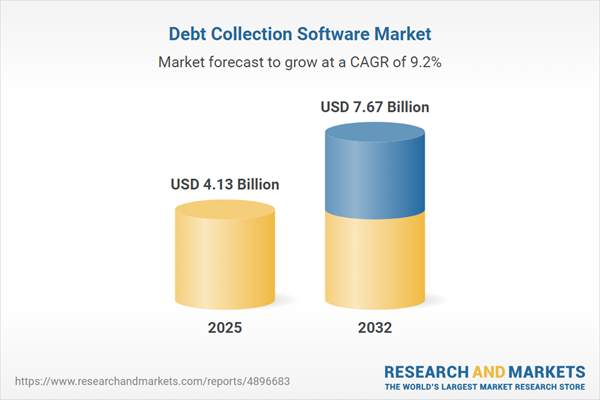Speak directly to the analyst to clarify any post sales queries you may have.
The debt collection software market is transforming how organizations recover accounts, manage risk, and ensure regulatory compliance. Senior decision-makers are now leveraging cloud-enabled platforms and integrated analytics to enhance operational agility and maintain a strong competitive edge.
Market Snapshot: Debt Collection Software Market Size, Growth, and Trajectory
The global debt collection software market continues to expand steadily, as the adoption of automated and digital solutions accelerates transformation within account recovery operations. Companies are seeking to manage increasingly complex debt portfolios efficiently while continuously adapting to evolving regulatory environments. Cloud-based platforms and versatile analytics cores are improving digital channel unification and expanding support for various financial sectors. Both large enterprises and mid-sized organizations are prioritizing digital-first processes to bolster adaptability, accelerate strategic decisions, and consistently deliver on robust compliance within a financial ecosystem characterized by rapid change.
Scope & Segmentation of the Debt Collection Software Market
This report presents a targeted view for senior leaders, focusing on strategic dimensions shaping debt collection software adoption and effectiveness across global markets:
- Component: Analysis covers core software products and accompanying service offerings, evaluating implementation, maintenance, and support processes needed to achieve operational transparency and reliable service outcomes.
- Deployment Modes: Considers both cloud and on-premise strategies, with a focus on infrastructure, security frameworks, and flexible scalability to meet evolving organizational priorities.
- Organization Sizes: Reviews integration models suitable for large corporations as well as small- and medium-sized enterprises, ensuring adaptability to diverse technology requirements and varying fiscal constraints.
- Verticals: Includes applications across banking, financial services, insurance, healthcare, retail, telecommunications, and public sector, outlining the compliance demands and customer engagement challenges unique to each context.
- Geographic Regions: Investigates key trends and regulatory drivers throughout the Americas, Europe, Middle East and Africa, and Asia-Pacific, noting regional policy variations and local approaches to technology adoption and market penetration.
- Key Technologies: Addresses the growing influence of artificial intelligence, machine learning, predictive analytics, omnichannel capabilities, encryption, and identity verification in enhancing compliance, data security, and operational performance.
- Competitive Landscape: Highlights leading industry providers, including Experian, Collexus, FICO, Microsoft, Pegasystems, and CGI, with an emphasis on their approaches to system integration, product development, innovative partnerships, and service enhancements.
Key Takeaways for Senior Decision-Makers
- Integrating automation and predictive analytics in collection workflows leads to greater process efficiency and more stringent compliance management across multiple business segments.
- Cloud-native solutions facilitate seamless integration with evolving fintech platforms, supporting continuous technological advancement and regulatory alignment for enterprises worldwide.
- Subscription and flexible licensing models support dynamic IT budgeting, allowing organizations to adjust spending to align with growth and risk management strategies.
- Strengthening organizational data protection policies is critical for meeting compliance standards, reducing operational vulnerabilities, and minimizing risk of regulatory penalties across regions and industries.
- Ongoing innovation and vendor collaboration enable organizations to maintain operational flexibility, maximize value, and respond effectively to changing market and regulatory landscapes.
- Customizing software deployments according to local regulatory environments facilitates effective compliance, localized risk management, and increased market viability in diverse jurisdictions.
Tariff Impact: Navigating US Trade Policy Shifts
Recent shifts in US hardware tariffs are accelerating the adoption of cloud-based and subscription procurement models within the debt collection software industry. These models help organizations control costs and mitigate risks stemming from variable tariff-related expenses. Solution providers are improving their compliance support and increasing direct engagement with clients to enhance operational flexibility in response to ongoing policy and regulatory changes.
Methodology & Data Sources
The research combines analysis of secondary sources, sector studies, and interviews with senior executives and regulatory authorities. All recommendations are verified for actionable relevance to senior leadership priorities and emerging industry practices.
Why This Report Matters: Strategic Value for Senior Leadership
- Offers a benchmarking tool for evaluating new technologies and compliance readiness as providers adapt to evolving operational requirements.
- Enables optimization of IT resources and risk management strategies, strengthening organizational resilience under fluctuating market and regulatory conditions.
- Supports focused allocation of resources to meet compliance and operational flexibility demands, ensuring alignment with evolving global market expectations.
Conclusion
This report equips senior leaders with actionable frameworks to strengthen technology strategies, manage regulatory dynamics, and build organizational resilience throughout debt collection operations.
Additional Product Information:
- Purchase of this report includes 1 year online access with quarterly updates.
- This report can be updated on request. Please contact our Customer Experience team using the Ask a Question widget on our website.
Table of Contents
3. Executive Summary
4. Market Overview
7. Cumulative Impact of Artificial Intelligence 2025
Companies Mentioned
The companies profiled in this Debt Collection Software market report include:- Experian Information Solutions, Inc.
- Collexus Pty Ltd.
- Arum Systems Ltd
- C&R Software
- CGI Inc.
- Civica
- Dexterous Holdings Pty Ltd
- Esker, Inc.
- FICO
- Genesys Cloud Services, Inc.
- JST CollectMax
- LeadSquared
- MaxContact
- Microsoft Corporation
- Pegasystems Inc.
- Pennant Technologies Private Limited
- TurnKey Lender Pte. Ltd.
- Wincollect Pty Ltd
Table Information
| Report Attribute | Details |
|---|---|
| No. of Pages | 199 |
| Published | November 2025 |
| Forecast Period | 2025 - 2032 |
| Estimated Market Value ( USD | $ 4.13 Billion |
| Forecasted Market Value ( USD | $ 7.67 Billion |
| Compound Annual Growth Rate | 9.2% |
| Regions Covered | Global |
| No. of Companies Mentioned | 19 |









